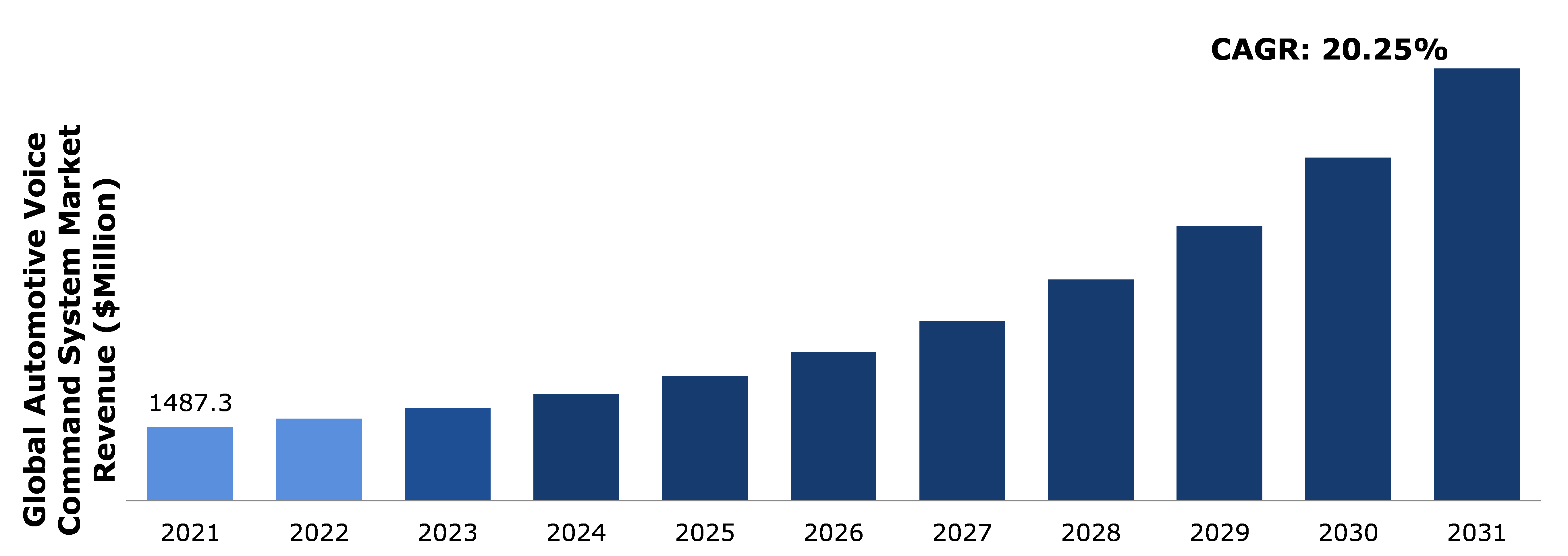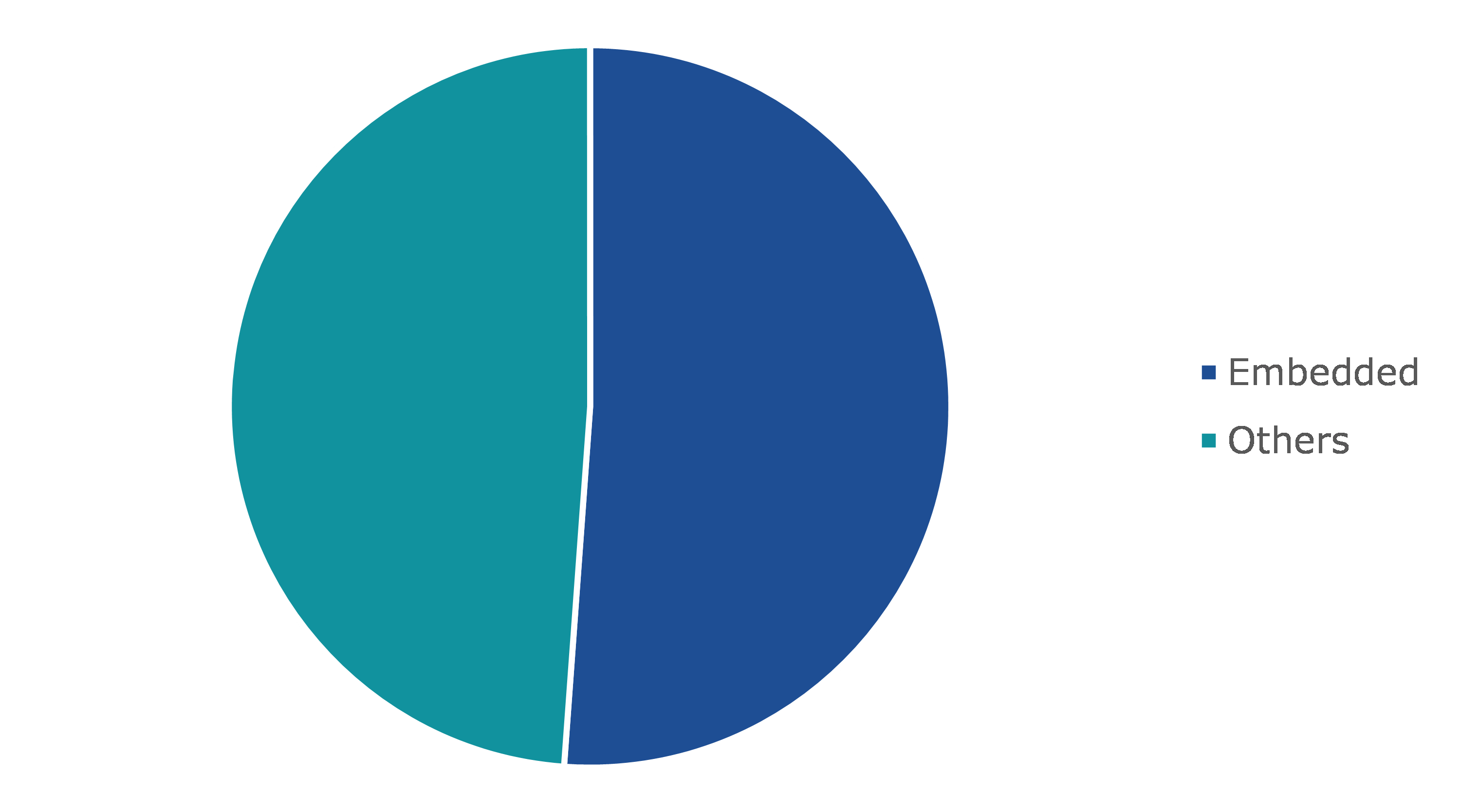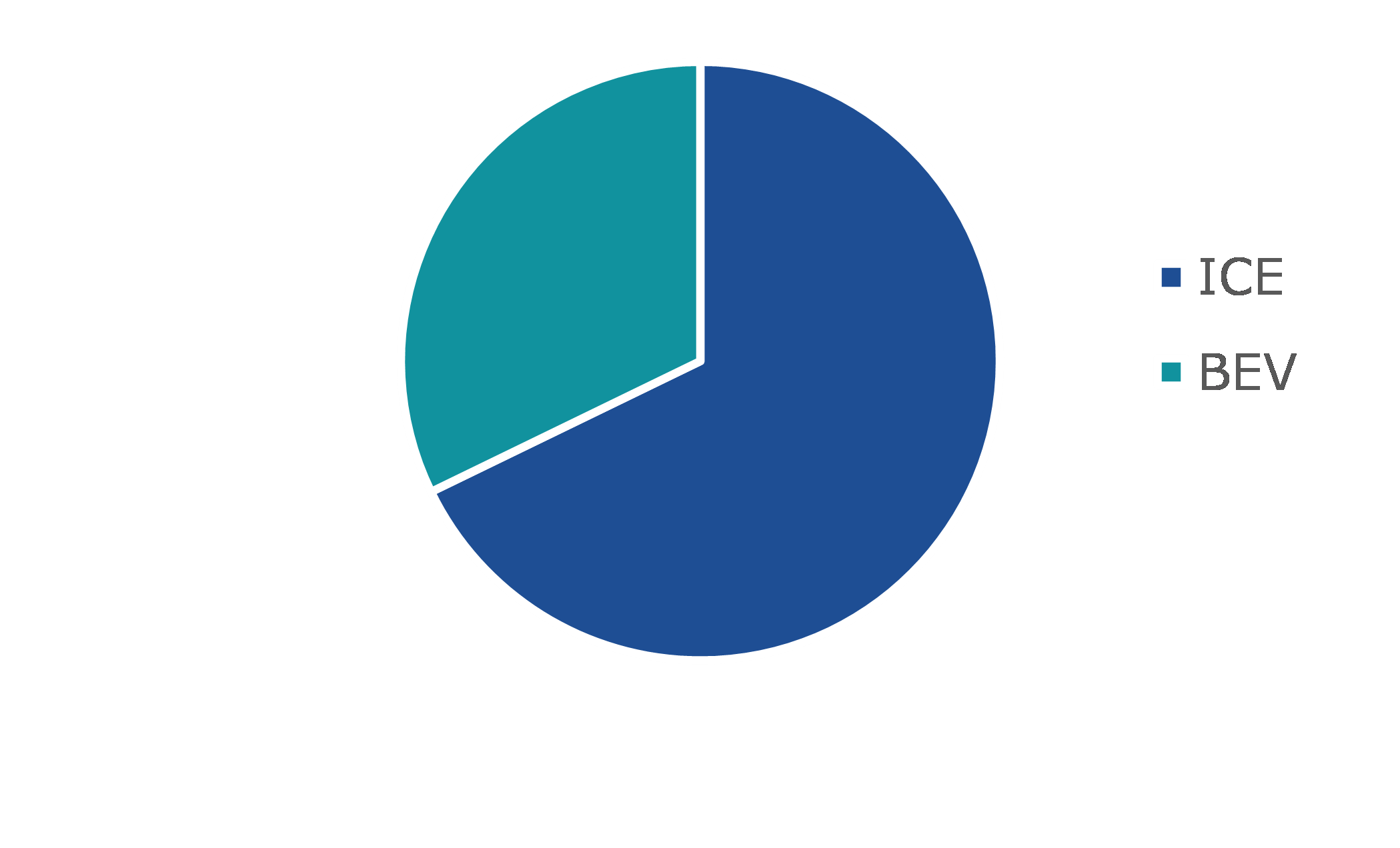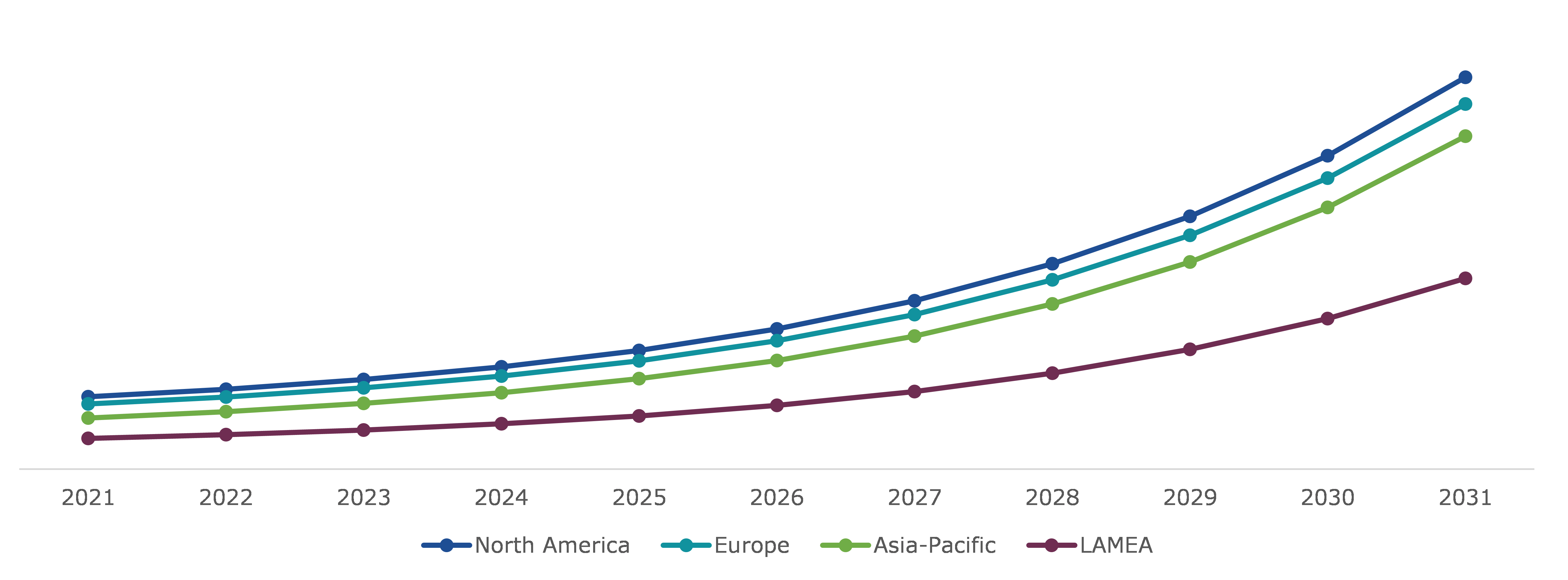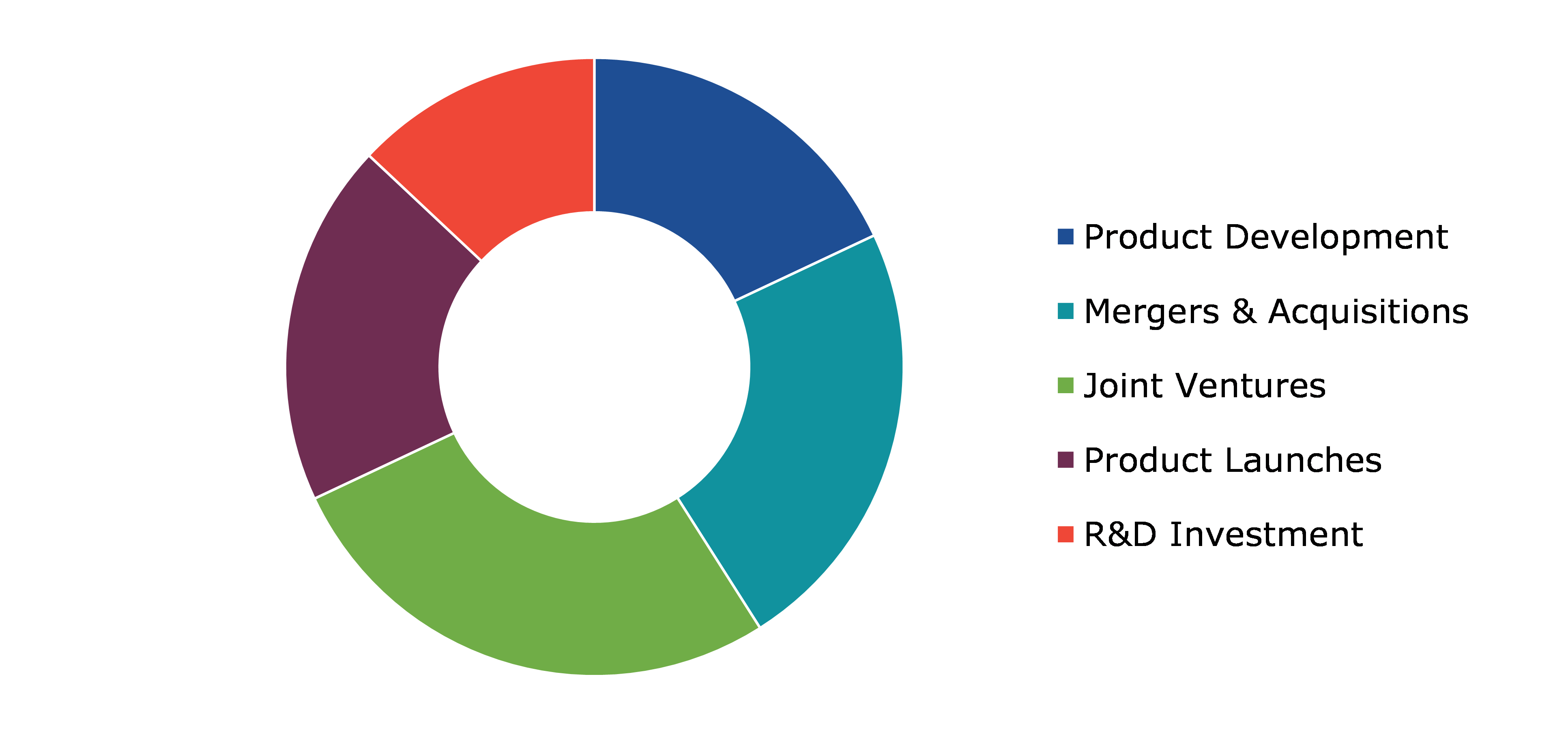Automotive Voice Command System Market Report
RA00164
Automotive Voice Command System Market by Technology (Embedded and Others), Application (AI and Non-AI), Vehicle Type (ICE and BEV), and Regional Analysis (North America, Europe, Asia-Pacific, and LAMEA): Global Opportunity Analysis and Industry Forecast, 2022-2031
Global Automotive Voice Command System Market Analysis
The global automotive voice command system market size was $1,487.3 million in 2021 and is predicted to grow with a CAGR of 20.25%, by generating revenue of $8,681.8 million by 2031.
Global Automotive Voice Command System Market Synopsis
The global automotive voice command system market is projected to grow at a substantial rate due to the increase in the adoption of digital technologies in the automotive industry. The surge in demand for vehicles across the globe is also anticipated to boost the demand for automotive voice command systems. The automotive voice command system is a new concept of voice recognition in the car which uses a speech recognition algorithm. The integration of voice commands in vehicles provides ease of use and safety. The increase in security concerns raises the need for voice recognition systems in vehicles. The global automotive voice command system market is expected to witness significant growth during the forecast period, owing to all these factors.
The high installation cost of the automotive voice command system can hinder market growth. The cost of the system plays a crucial role in the automotive voice command system market trends. Car manufacturers are consistently improving the voice command system in their vehicles to provide users ease of use. The major players in the automotive voice command system market are increasingly collaborating to reduce the cost and improve the voice command system using artificial intelligence (AI) technology. This, in turn, may offer ample growth opportunities to the market players during the forecast period. For instance, in 2019, Nuance Communications, Inc. one of the major leaders in conversational AI innovations, announced that it will power BMW Intelligent Personal Assistant, which is an AI-powered digital companion that allows users to operate their car using voice commands.
Based on regional analysis, the North America region is projected to dominate the market over the forecast period, owing to the presence of major market players, increase in disposable income, and evolution of in-car voice control systems. Whereas, the Asia-Pacific region is anticipated to witness the fastest growth over the forecast period due to various factors such as a rapid increase in urban population, and the presence of giant automotive manufacturers.
Automotive Voice Command System Overview
The automotive voice command systems in the car use the concept of speech recognition technology. This technology is highly becoming popular among people across the globe. Several advancements in speech recognition algorithms are being made keeping users’ safety in mind while driving. Various studies show that driver distraction levels are much higher while using touchscreen gadgets compared to voice command systems.
COVID-19 Impact on Global Automotive Voice Command System Market
The COVID-19 pandemic had a negative impact on the automotive sector across the world. The strict lockdowns resulted in the shutting down of production at original equipment manufacturers (OEMs). This in turn has disrupted the supply chain across major industries globally. The steep decline in sales of all vehicle categories led to losses in revenue and disruption in the cash flow of the automotive companies. Asia-Pacific consists of the two most populated countries where the sale of automobile vehicles is remarkable. During the COVID-19 pandemic, the sales of vehicles in both countries declined sharply owing to severe COVID-19 restrictions. Due to all these factors, the automotive voice command system market growth was also impacted.
The post-COVID-19 scenario for the automotive sector is positive as several countries have eased strict lockdowns. Automakers around the world are witnessing significant levels of vehicle production as customers are returning to dealers to purchase vehicles. This, in turn, is anticipated to drive the automotive voice command system market demand during the analysis timeframe.
Surge in Automobile Sales Along with an Increase in the Adoption of Digital Technologies is anticipated to drive the Market Growth
The surge in demand for vehicles across the world is driving the global automotive voice command system market share. Ease in supply chain disruptions of semiconductors post-COVID-19 outbreak led several passenger vehicle manufacturers to register strong vehicle sales. In the automotive industry, consumers are increasingly inclined toward experiencing an advanced and better in-car experience, due to which there is a massive surge in digital transformation in the automotive sector. In addition to these factors, an increase in consumer spending capacity on premium services and technological advancements for safety and comfort is anticipated to boost the demand for automotive voice command systems.
To know more about global automotive voice command system market drivers, get in touch with our analysts here.
High Installation Cost of Automotive Voice Command System is Restraining the Market Growth
Automobile manufacturers are consistently improving the voice command system in their vehicles to provide users with ease of use and the most luxurious in-car experience. Currently, the system has been majorly equipped in luxury cars and at a very low rate in mid and low-end cars due to its high installation cost. In developing countries, the demand for cars is mostly in the mid and low-price range, owing to the majority of people falling in the middle-class income group being attracted by mid and low-end price-range cars. These factors are anticipated to hinder the automotive voice command system market opportunity during the forecast period.
A Motor-Cycle Intelligent Biometric Voice Command System is Expected to Create Excellent Opportunities in the Global Market
Motorcycle manufacturers are also developing voice command systems for their bikes due to the increase in popularity of the systems among people. The voice command system makes it possible to optimize the real-time use of motorcycle and driver assistance technology. For instance, Kawasaki Motors is developing a voice command system for bikes that use AI technology. The system will allow bike riders to control motorcycles using their speech commands. In addition, there has been an increase in innovations in helmets that consists of a voice module that can turn on the indication, horn, headlights, and also ignition system. All these factors are anticipated to create ample opportunities for the key players operating in the automotive voice command system industry.
To know more about global automotive voice command system market opportunities, get in touch with our analysts here.
Global Automotive Voice Command System Market Size, by Technology
Based on technology, the market has been classified into embedded and others. Among these, the others sub-segment is estimated to witness the fastest growth during the forecast period. The others sub-segment is further divided into hybrid and cloud.
Global Automotive Voice Command System Market Share, by Technology, 2021
Source: Research Dive Analysis
The others sub-segment is anticipated to grow at the fastest rate during the forecast period, owing to the extensive demand for internet connectivity across the world. Growth in the number of connected devices is expected to increase significantly during the forecast period. This, in turn, is further projected to drive segment growth. Cloud-based technology utilizes the historical data of a user which boosts the users’ in-car experience and offers comfort and smooth operations of the vehicle systems. It also offers several other benefits including live access to maps, music, and other features.
Global Automotive Voice Command System Market, by Application
Based on application, the market has been divided into AI and non-AI. Among these, the AI sub-segment accounted for the highest revenue share in 2021 and is estimated to witness the fastest growth during the forecast period.
Global Automotive Voice Command System Market Share, by Application, 2021
Source: Research Dive Analysis
The AI sub-segment is anticipated to have a dominant market share during the forecast period. This can be majorly attributed to the augmentation of virtual voice assistants such as Apple Siri, Amazon Alexa, Google Assistant, and others in the market. The ability to receive, interpret, and carry out voice commands in real-time is a major feature that is projected to drive the growth of the sub-segment. An increase in the number of autonomous/self-driving cars is also boosting the adoption of AI-enabled voice command systems in automotive vehicles across the globe.
Global Automotive Voice Command System Market Trends, by Vehicle Type
Based on vehicle type, the market has been classified into Internal Combustion Engine (ICE) and Battery Electric Vehicle (BEV). Among these, the ICE sub-segment accounted for the highest revenue share in 2021, whereas the BEV sub-segment is anticipated to witness the fastest growth rate during the forecast period.
Global Automotive Voice Command System Market Value, by Vehicle Type, 2021
Source: Research Dive Analysis
The ICE sub-segment is projected to have a dominant market share and generate substantial revenue by 2031, owing to the increase in sales, production, and adoption of ICE vehicles in various countries. Also, an increase in disposable income along with the increase in urbanization and the rising need for private commuting is predicted to drive the growth of the ICE sub-segment. Furthermore, the manufacturers adopted voice command systems in ICE vehicles much before the BEV were introduced to the market.
The BEV sub-segment is anticipated to be the fastest-growing sub-segment during the forecast period. BEV sales increased significantly in 2021 and have remained strong so far in 2022. The increase in sales of BEVs can be attributed to an increase in global warming concerns, robust government and corporate initiatives to lower greenhouse gas emissions across the globe. Also, the push for the rollout of accessible charging infrastructure and various incentives for the purchase of greener vehicles by government entities is increasing BEV adoption among people.
Global Automotive Voice Command System Market Forecast, Regional Insights
The automotive voice command system market was investigated across North America, Europe, Asia-Pacific, and LAMEA.
Global Automotive Voice Command System Market Size & Forecast, by Region, 2021-2030 (USD Million)
Source: Research Dive Analysis
The Market for Automotive Voice Command System in North America to be the Most Dominant
The North America region dominated the automotive voice command system market in 2021 and is expected to remain dominant throughout the forecast timeframe. Some of the factors attributed to the substantial growth of the automotive voice command system market across North America is the presence of major players, increase in disposable income, growing demand for luxury products, and an increase in demand for personal vehicles. Furthermore, an increase in the popularity of electric vehicles in the region owing to an increase in awareness regarding global warming among the population is anticipated to boost the adoption of advanced EVs installed with an automotive voice command system.
Competitive Scenario in the Global Automotive Voice Command System Market
Investment, agreement, product launches, developments, and partnerships are some of the common strategies followed by major market players. For instance, in 2020, Lamborghini became the first automaker to integrate Amazon Alexa to control a vehicle’s system and Ford became the first carmaker to incorporate Alexa’s cloud-based system.
Source: Research Dive Analysis
Some of the leading automotive voice command system market players are Nuance Communications, Inc., Microsoft Corporation, Alphabet, Amazon.com, Inc., Apple Inc., BMW AG, Daimler AG, Ford Motor Company, LumenVox, and Sensory Inc.
| Aspect | Particulars |
| Historical Market Estimations | 2019-2020 |
| Base Year for Market Estimation | 2021 |
| Forecast Timeline for Market Projection | 2022-2030 |
| Geographical Scope | North America, Europe, Asia-Pacific, and LAMEA |
| Segmentation by Technology |
|
| Segmentation by Application |
|
| Segmentation by Vehicle Type |
|
| Key Companies Profiled |
|
Q1. What is the size of the global automotive voice command system market?
A. The size of the global automotive voice command system market was over $1,487.3 million in 2021 and is projected to reach $8,681.8 million by 2031.
Q2. Which are the major companies in the automotive voice command system market?
A. Nuance Communications, Inc., Microsoft Corporation, and Alphabet are some of the key players in the global automotive voice command system market.
Q3. Which region, among others, possesses greater investment opportunities in the near future?
A. Asia-Pacific region possesses great investment opportunities for investors in the future.
Q4. What will be the growth rate of the Asia-Pacific automotive voice command system market?
A. Asia-Pacific automotive voice command system market is anticipated to grow at 21.57% CAGR during the forecast period.
Q5. What are the strategies opted by the leading players in the market?
A. Agreement and investment are the two key strategies opted by the operating companies in the market.
Q6. Which companies are investing more on R&D practices?
A. Ford Motor Company, BMW AG, and Daimler AG are the companies investing more on R&D activities for developing new products and technologies.
1.Research Methodology
1.1.Desk Research
1.2.Real time insights and validation
1.3.Forecast model
1.4.Assumptions and forecast parameters
1.5.Market size estimation
1.5.1.Top-down approach
1.5.2.Bottom-up approach
2.Report Scope
2.1.Market definition
2.2.Key objectives of the study
2.3.Report overview
2.4.Market segmentation
2.5.Overview of the impact of COVID-19 on Global Automotive Voice Command System Market
3.Executive Summary
4.Market Overview
4.1.Introduction
4.2.Growth impact forces
4.2.1.Drivers
4.2.2.Restraints
4.2.3.Opportunities
4.3.Market value chain analysis
4.3.1.List of component providers
4.3.2.List of manufacturers
4.3.3.List of distributors
4.4.Innovation & sustainability matrices
4.4.1.Technology matrix
4.4.2.Regulatory matrix
4.5.Porter’s five forces analysis
4.5.1.Bargaining power of suppliers
4.5.2.Bargaining power of consumers
4.5.3.Threat of substitutes
4.5.4.Threat of new entrants
4.5.5.Competitive rivalry intensity
4.6.PESTLE analysis
4.6.1.Political
4.6.2.Economical
4.6.3.Social
4.6.4.Technological
4.6.5.Environmental
4.7.Impact of COVID-19 on Automotive Voice Command System market
4.7.1.Pre-covid market scenario
4.7.2.Post-covid market scenario
5.Automotive Voice Command System Market Analysis, by Technology
5.1.Overview
5.2.Embedded
5.2.1.Definition, key trends, growth factors, and opportunities
5.2.2.Market size analysis, by region, 2022-2031
5.2.3.Market share analysis, by country, 2022-2031
5.3.Others
5.3.1. Definition, key trends, growth factors, and opportunities
5.3.2.Market size analysis, by region, 2022-2031
5.3.3.Market share analysis, by country, 2022-2031
5.4.Research Dive Exclusive Insights
5.4.1.Market attractiveness
5.4.2.Competition heatmap
6.Automotive Voice Command System Market Analysis, by Application
6.1.Overview
6.2.AI
6.2.1.Definition, key trends, growth factors, and opportunities
6.2.2.Market size analysis, by region, 2022-2031
6.2.3.Market share analysis, by country, 2022-2031
6.3.Non-AI
6.3.1.Definition, key trends, growth factors, and opportunities
6.3.2.Market size analysis, by region, 2022-2031
6.3.3.Market share analysis, by country, 2022-2031
6.4.Research Dive Exclusive Insights
6.4.1.Market attractiveness
6.4.2.Competition heatmap
7.Automotive Voice Command System Market Analysis, by Vehicle Type
7.1.Overview
7.2.ICE
7.2.1.Definition, key trends, growth factors, and opportunities
7.2.2.Market size analysis, by region, 2022-2031
7.2.3.Market share analysis, by country, 2022-2031
7.3.BEV
7.3.1.Definition, key trends, growth factors, and opportunities
7.3.2.Market size analysis, by region, 2022-2031
7.3.3.Market share analysis, by country, 2022-2031
7.4.Research Dive Exclusive Insights
7.4.1.Market attractiveness
7.4.2.Competition heatmap
8.Automotive Voice Command System Market, by Region
8.1.North America
8.1.1.U.S.
8.1.1.1.Market size analysis, by Technology, 2022-2031
8.1.1.2.Market size analysis, by Application, 2022-2031
8.1.1.3.Market size analysis, by Vehicle Type, 2022-2031
8.1.2.Canada
8.1.2.1.Market size analysis, by Technology, 2022-2031
8.1.2.2.Market size analysis, by Application, 2022-2031
8.1.2.3.Market size analysis, by Vehicle Type, 2022-2031
8.1.3.Mexico
8.1.3.1.Market size analysis, by Technology, 2022-2031
8.1.3.2.Market size analysis, by Application, 2022-2031
8.1.3.3.Market size analysis, by Vehicle Type, 2022-2031
8.1.4.Research Dive Exclusive Insights
8.1.4.1.Market attractiveness
8.1.4.2.Competition heatmap
8.2.Europe
8.2.1.Germany
8.2.1.1.Market size analysis, by Technology, 2022-2031
8.2.1.2.Market size analysis, by Application, 2022-2031
8.2.1.3.Market size analysis, by Vehicle Type, 2022-2031
8.2.2.UK
8.2.2.1.Market size analysis, by Technology, 2022-2031
8.2.2.2.Market size analysis, by Application, 2022-2031
8.2.2.3.Market size analysis, by Vehicle Type, 2022-2031
8.2.3.France
8.2.3.1.Market size analysis, by Technology, 2022-2031
8.2.3.2.Market size analysis, by Application, 2022-2031
8.2.3.3.Market size analysis, by Vehicle Type, 2022-2031
8.2.4.Spain
8.2.4.1.Market size analysis, by Technology, 2022-2031
8.2.4.2.Market size analysis, by Application, 2022-2031
8.2.4.3.Market size analysis, by Vehicle Type, 2022-2031
8.2.5.Italy
8.2.5.1.Market size analysis, by Technology, 2022-2031
8.2.5.2.Market size analysis, by Application, 2022-2031
8.2.5.3.Market size analysis, by Vehicle Type, 2022-2031
8.2.6.Rest of Europe
8.2.6.1.Market size analysis, by Technology, 2022-2031
8.2.6.2.Market size analysis, by Application, 2022-2031
8.2.6.3.Market size analysis, by Vehicle Type, 2022-2031
8.2.7.Research Dive Exclusive Insights
8.2.7.1.Market attractiveness
8.2.7.2.Competition heatmap
8.3.Asia-Pacific
8.3.1.China
8.3.1.1.Market size analysis, by Technology, 2022-2031
8.3.1.2.Market size analysis, by Application, 2022-2031
8.3.1.3.Market size analysis, by Vehicle Type, 2022-2031
8.3.2.Japan
8.3.2.1.Market size analysis, by Technology, 2022-2031
8.3.2.2.Market size analysis, by Application, 2022-2031
8.3.2.3.Market size analysis, by Vehicle Type, 2022-2031
8.3.3.India
8.3.3.1.Market size analysis, by Technology, 2022-2031
8.3.3.2.Market size analysis, by Application, 2022-2031
8.3.3.3.Market size analysis, by Vehicle Type, 2022-2031
8.3.4.Australia
8.3.4.1.Market size analysis, by Technology, 2022-2031
8.3.4.2.Market size analysis, by Application, 2022-2031
8.3.4.3.Market size analysis, by Vehicle Type, 2022-2031
8.3.5.South Korea
8.3.5.1.Market size analysis, by Technology, 2022-2031
8.3.5.2.Market size analysis, by Application, 2022-2031
8.3.5.3.Market size analysis, by Vehicle Type, 2022-2031
8.3.6.Rest of Asia-Pacific
8.3.6.1.Market size analysis, by Technology, 2022-2031
8.3.6.2.Market size analysis, by Application, 2022-2031
8.3.6.3.Market size analysis, by Vehicle Type, 2022-2031
8.3.7.Research Dive Exclusive Insights
8.3.7.1.Market attractiveness
8.3.7.2.Competition heatmap
8.4.LAMEA
8.4.1.Brazil
8.4.1.1.Market size analysis, by Technology, 2022-2031
8.4.1.2.Market size analysis, by Application, 2022-2031
8.4.1.3.Market size analysis, by Vehicle Type, 2022-2031
8.4.2.Saudi Arabia
8.4.2.1.Market size analysis, by Technology, 2022-2031
8.4.2.2.Market size analysis, by Application, 2022-2031
8.4.2.3.Market size analysis, by Vehicle Type, 2022-2031
8.4.3.UAE
8.4.3.1.Market size analysis, by Technology, 2022-2031
8.4.3.2.Market size analysis, by Application, 2022-2031
8.4.3.3.Market size analysis, by Vehicle Type, 2022-2031
8.4.4.South Africa
8.4.4.1.Market size analysis, by Technology, 2022-2031
8.4.4.2.Market size analysis, by Application, 2022-2031
8.4.4.3.Market size analysis, by Vehicle Type, 2022-2031
8.4.5.Rest of LAMEA
8.4.5.1.Market size analysis, by Technology, 2022-2031
8.4.5.2.Market size analysis, by Application, 2022-2031
8.4.5.3.Market size analysis, by Vehicle Type, 2022-2031
8.4.6.Research Dive Exclusive Insights
8.4.6.1.Market attractiveness
8.4.6.2.Competition heatmap
9.Competitive Landscape
9.1.Top winning strategies, 2021
9.1.1.By strategy
9.1.2.By year
9.2.Strategic overview
9.3.Market share analysis, 2021
10.Company Profiles
10.1.Nuance Communications, Inc.
10.1.1.Overview
10.1.2.Business segments
10.1.3.Product portfolio
10.1.4.Financial performance
10.1.5.Recent developments
10.1.6.SWOT analysis
10.1.7.Research Dive Analyst View
10.2.Microsoft Corporation
10.2.1.Overview
10.2.2.Business segments
10.2.3.Product portfolio
10.2.4.Financial performance
10.2.5.Recent developments
10.2.6.SWOT analysis
10.2.7.Research Dive Analyst View
10.3.Alphabet
10.3.1.Overview
10.3.2.Business segments
10.3.3.Product portfolio
10.3.4.Financial performance
10.3.5.Recent developments
10.3.6.SWOT analysis
10.3.7.Research Dive Analyst View
10.4.Amazon.com, Inc.
10.4.1.Overview
10.4.2.Business segments
10.4.3.Product portfolio
10.4.4.Financial performance
10.4.5.Recent developments
10.4.6.SWOT analysis
10.4.7.Research Dive Analyst View
10.5.Apple Inc.
10.5.1.Overview
10.5.2.Business segments
10.5.3.Product portfolio
10.5.4.Financial performance
10.5.5.Recent developments
10.5.6.SWOT analysis
10.5.7.Research Dive Analyst View
10.6.BMW AG
10.6.1.Overview
10.6.2.Business segments
10.6.3.Product portfolio
10.6.4.Financial performance
10.6.5.Recent developments
10.6.6.SWOT analysis
10.6.7.Research Dive Analyst View
10.7.Daimler AG.
10.7.1.Overview
10.7.2.Business segments
10.7.3.Product portfolio
10.7.4.Financial performance
10.7.5.Recent developments
10.7.6.SWOT analysis
10.7.7.Research Dive Analyst View
10.8.Ford Motor Company
10.8.1.Overview
10.8.2.Business segments
10.8.3.Product portfolio
10.8.4.Financial performance
10.8.5.Recent developments
10.8.6.SWOT analysis
10.8.7.Research Dive Analyst View
10.9.LumenVox
10.9.1.Overview
10.9.2.Business segments
10.9.3.Product portfolio
10.9.4.Financial performance
10.9.5.Recent developments
10.9.6.SWOT analysis
10.9.7.Research Dive Analyst View
10.10.Sensory Inc.
10.10.1.Overview
10.10.2.Business segments
10.10.3.Product portfolio
10.10.4.Financial performance
10.10.5.Recent developments
10.10.6.SWOT analysis
10.10.7.Research Dive Analyst View
11.Appendix
11.1.Parent & peer market analysis
11.2.Premium insights from industry experts
11.3.Related reports
In recent years, there have been marvelous developments in the automotive sector. The integration of automotive voice command systems in vehicles is one of the significant advancements the automotive industry has witnessed. In past few years, there has been a significant rise in the demand for autonomous vehicles equipped with voice command features across the globe, owing to the ease they offer to the user. Automobile manufacturers are constantly working on advancing the voice command systems in their vehicles to offer drivers a smooth driving experience.
Today’s consumers are highly conscious of safety and security while driving vehicles. Numerous studies depict that a driver’s distraction level is much higher while operating touchscreen devices as compared to voice command systems. Hence, there is a tremendous demand for automotive voice command systems in vehicles for safety reasons, which is driving the revenues of the global automotive voice command system market.
Newest Insights in the Automotive Voice Command System Market
The growing integration of digital technologies and high-end features in vehicles by automakers is boosting the global market. As per a report by Research Dive, the global automotive voice command system market is expected to hit $8,681.8 million and grow with a remarkable CAGR of 20.25% in the 2022–2031 timeframe. The North America automotive voice command system market is projected to observe leading growth in the coming years. This is because of the massive demand for automotive voice command systems in vehicles, rising disposable income of people, and growing demand for luxury features in cars in the region. Moreover, the rising trend for electric vehicles in this region is also responsible for the growth of the market.
How are the Market Players Responding to the Growing Demand for Automotive Voice Command Systems?
Market players are greatly implementing ground-breaking business strategies and investing in new developments to fulfil to the rising demand for automotive voice command systems. Some of the leading players in the automotive voice command system market are Nuance Communications, Inc., LumenVox, Microsoft Corporation, Alphabet, Apple Inc., Amazon.com, Inc., Daimler AG, Ford Motor Company, BMW AG, Sensory Inc., and others. These players are focused on planning and devising tactics such as mergers and novel advances, acquisitions, collaborations, and partnerships to attain a robust position in the global market.
For instance,
- In July 2020, Kia Motors, a South Korean multinational automobile manufacturer, introduced innovative voice commands and safety features to its UVO connected car system. This novel voice-assisted wake-up command of the UVO system can be switched on by the user saying 'Hello Kia'.
- In December 2021, Cerence Inc., a global industry leader in developing unique, moving experiences for the automotive world, joined hands with Micware, Co., Ltd., a Japanese firm focused on the development of advanced automotive software. The partnership aims to build applications and voice-powered assistants for Japanese two-wheeler manufacturers.
- In February 2022, Maruti Suzuki, an Indian automobile manufacturer, announced to launch a new Maruti Baleno equipped with Amazon Alexa support. Baleno owners can give commands through paired Alexa devices.
COVID-19 Impact on the Global Automotive Voice Command System Market
The sudden rise of the coronavirus pandemic in 2020 has adversely impacted the global automotive voice command system market. The demand for vehicles reduced considerably during the pandemic due to travel restrictions and economic downfall in numerous countries. Also, a sudden stoppage in the operations of the automotive industry due to lockdown restrictions hindered the production of automotive voice command systems during the pandemic. All these factors significantly obstructed the market growth during the pandemic period. However, as the pandemic is relaxing since the end of 2021, the market is anticipated to observe enormous growth in the forthcoming years owing to the rising advancements by market players in automotive voice command system technologies.
Personalize this research
- Triangulate with your own data
- Request your format and definition
- Get a deeper dive on a specific application, geography, customer or competitor
- + 1-888-961-4454 Toll - Free
- support@researchdive.com

